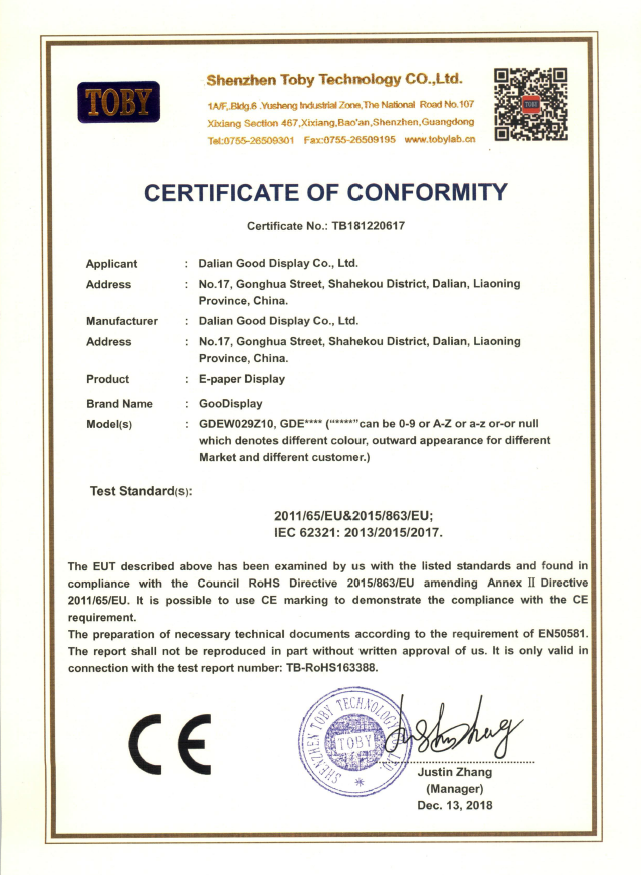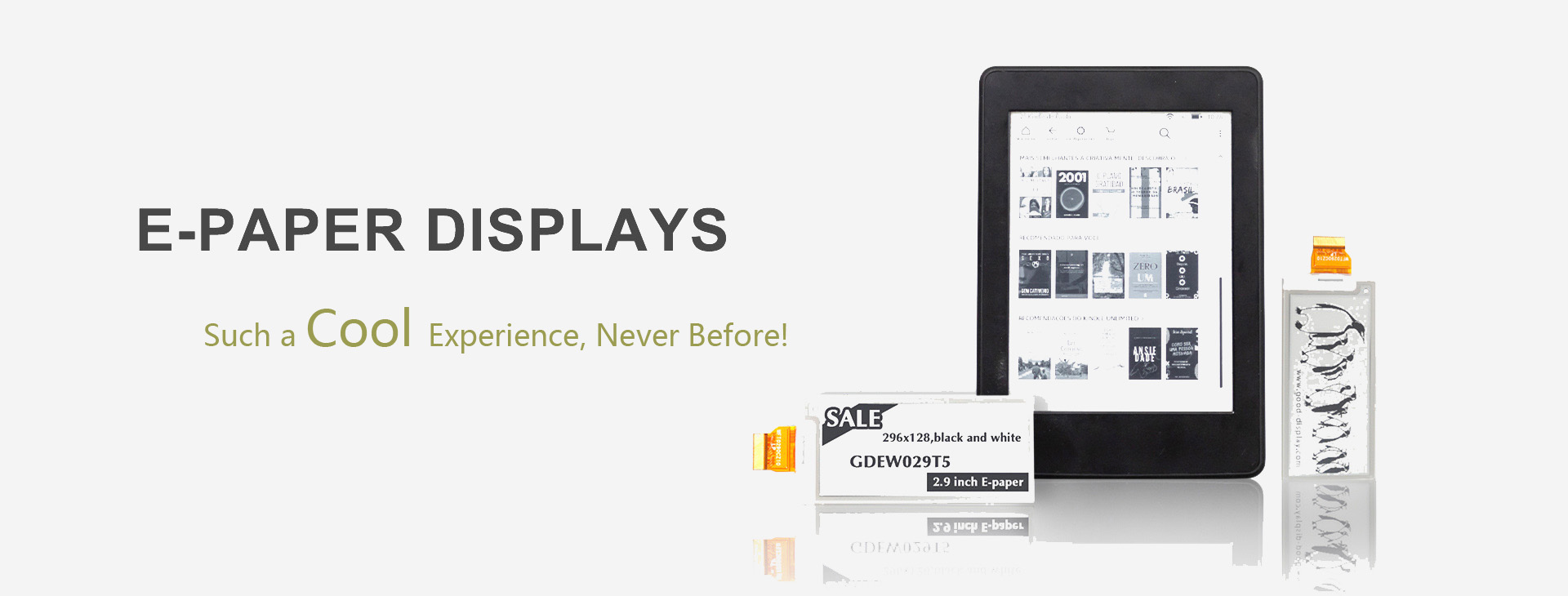Answer:
We have compiled all the collected e-paper FAQs into a small tool that allows customers to easily find out the answers themselves. If you have a need, please click here to view.

Q: Are your E-Paper Displays RoHS compliant?
A: All of Good Display E-Paper Displays are RoHS compliant.

Q: What is the difference between an Matrix display and an Segmented display?
A: The underlying ePaper technology is very similar but is tuned to the needs of the different applications of a Matrix display versus a Segmented display.
Matrix displays are intended for applications requiring the display of many different forms of text and images. These displays comprise of a large array of pixels. These individual pixels are controlled by a TFT array similar to what you will have a typical computer monitor or TV screen.
Segmented displays are intended for applications where the display requirements can be met using predefined segments that can be turned on or off. This is similar to what one would see in a typical calculator with a numeric or alphanumeric display.
Basically will the display be made up of an array of pixels or by a collection of predefined shapes.
Q: What is Good Display's minimum purchase quantity for Matrix e-paper displays? And what about the small size, for example, 2.9 inch?
A: You can purchase one unit matrix display for standard products, but you must have 100,000 unit and even more volume for custom products, this varies based on the size and requirements of the display application and whether it is a custom or standard size display. It is best to discuss your requirements with a member of our sales team. And for the small size(less than 3.5 inches), the molding fee is about 100,000 US dollars, the MOQ is 500K.
Q: What is the pricing for Good Display Matrix E-ink displays?
A: Pricing for Matrix displays depends on volumes and whether the display is a custom or standard display. The main driver of pricing is the overall display size, whether the display is monochrome or color.
And you can get the current pricing for Matrix E-ink displays from the following linking.
Q: How large/small can Matrix e-ink displays be?
A: The size and shape of a Matrix e-ink display is totally dictated by the size of the electrical backplane that the FPL is laminated to. Displays can be very small or very large. E Ink has standard display modules. Almost any size and shape can be made depending on the volumes.
At present, the largest e-ink display is 32 inch E-ink Display, and the smallest e-ink display is 1.02 inch E-ink Display.
Q: What voltage is required to drive a Matrix e-ink display?
A: The drive for E Ink displays is typically 15 volts. An ecosystem of electronic components exists for design of complete epaper systems.
Q: How much power does a Matrix e-ink display consume?
A: Matrix e-ink displays are bi-stable. This means that they only consume power while the display is being updated. No power is required to maintain an image after it has been updated. The power required to for the update process depends on the size of the display but is of the order of microwatts.
Q: Does Good Display have developer kits for Matrix products?
A: Yes there are E-ink display developer kits available for Matrix products from Good Display. and you can buy these development kits online or contact our sales.
Q: Does Good Display have a color product or is it only monochrome?
A: Good Display does have a color and tri-color E-paper display products, you can learn more by visiting color e-paperand tri-color e-paper.
Q: How long does it take to update an image on an Matrix e-ink display?
A: An e-ink display module supports numerous modes for updating the display. Different modes exist to support the different update requirements. Update times can be as short as 300 msec. for the entire display. Also to consider is that because e-ink screens are bi-stable, only the regions of the screen that are changing require updating. Any pixels that are not changing do not require updating.
Q: Can an Matrix e-ink display support animation or video rates?
A: Using the faster update modes, e-ink screens can support animation quality video rates. A number of examples are available from customers that show examples of e-ink screens showing video.
Q: Does Good Display provide or support flexible matrix displays?
A: The flexibility of an EPD display is controlled by the backplane. Good Display does support flexible backplanes, if you're intrested, please contact us.
Q: What is the thickness of an Matrix E-Paper display?
A: Thicknesses range from 1mm to 1.2 mm. This includes the FPL, protective sheet and the glass TFT backplane.
Q: What is the temperature range for Matrix E-Paper displays?
A: The operating temperature range for a Matrix e-ink display is from 0°C-50 °C, and the storage temperature range is from -20°C-70°C.
The operating temperature range for a Matrix DES display is from -20°C-60 °C, and the storage temperature range is from -25°C-70°C.
Q: What is waveform?
A: Waveform are predefined voltage impulse sequences used by display controller to manipulate ink.
The voltage sequence and temperature range are stored in a lookup Table(LUT) and is precisely paired to the display by production lots to enable precise placement of pigment to achieve accurate gray-level.
Q: Why does waveform need?
A: Because of every lots of E INK material has slightly different at ink characteristics which effects are temperature dependent.
So, waveform is a driving method which consider the factor of temperature, production lot, display size and waveform type to control the each lots of EPD performance at same range, and this is Good Display's responsibility to provide the suitable waveform to our customer.
Q: What are the types of waveform mode?
A: The waveform mode optional argument allows you to select the type of waveform update.
WF type | Updated time | Bit depth | Properties |
INIT | 4 sec | 1 | The INIT waveform flashes the display and drives the display to a white state. Used this waveform if the display is in an unknown state such as when the previous image is unknown due to reboot, or just test the host function. |
MU/DU | 260 ms | 1 | Direct update is only used when pixels are updating from any gray-level to either white to black such as handwriting or menu. Gray pixels will not be affected, MU/DU is about twice as fast as GC or GU. |
GU | 780 ms | 2~4 | Grayscale Update is a non-flashing waveform that can be used to update changing grayscale pixels. |
GC4/8/16 | 600/780/980 ms | 2~4 | Grayscale Clear is a flashing waveform used to provide the accurate update performance. All pixels are updated or cleared. |
Q: What is the normal product lifetime of Good Display's e-Paper display?
A: For standard products, it is a minimum of 5 years or the times of refresh is 1,000,000.
Q: Do Good Display E-Paper Displays have CE certification?
A: CE certification is typically given to end products. Since the E-Paper Display is a component, it does not carry CE certification.
Q:Can it be realistic? If want to integrate the circuit onto the e paper FPC to replace PCB directly, the PCB will not be used in the product, and the FPC of the epaper need open a mould
A: If the FPC fixed with the components will have a yield problem. The FPC is bendable and it is easy to cause the loss of the components. This solution cannot be operated.
Q: Can you do an irregular shape segmen E paper?
A: Yes,, we can .As long as the number of segment is not too many and IC is easy to choose. Additionally, PCB is more easy packaging than that of flexible one . But we can do if must be, tooling cost will be higher 20% - 30% than normal type segment E paper .
Q: Can large size monochrome or color E paper support FPC open mould?
A: Yes. Minimum order is 10K.The sample delivery date is 25 to 30 days after payment of the model fee.
Q: What does LUT and OTP stand for?
A: LUT stands for external waveform, OTP represents the built-in waveform.
Q: How to set LUT for OTP support products?
A: The partial refresh support product needs LUT, and the rest can be.
Q: Partial refresh remnant shadow problem for GDEW0154D27
A: Extend the refresh time, add a full update after several times.
Q: What is the voltage of adapt board?
A: 3.3 V, 5 V without any connection.
Q: The reason for the horizontal bar in the three color electronic paper.
A: There is a possibility of a horizontal bar for hardware settings and improper changes in software programs.
Q: The cause of red diffusion in the short time after the refresh of the color electronic paper.
A: When the steady state is not established, the refresh is stopped.
Q: Why is a SPI Epaper screen longer than a parallel screen when updating?
A: Because the serial port only transmits 1 bit of data at a time, the parallel way can be transmitted simultaneously.
Q: Storage humidity for electronic paper.
A: 40% to 70%.
Q: Is the E paper display can work on Operation Conditions: Temperature 0℃~40 ℃ ; Humidity 5%~90% RH ?
A:The operating Temperature is okay, but we recommend the suitable Humidity is from 35% to 65% RH.
Q: If it is acceptable for Indoor Humidity about 30-60% in Summer & 30-80% in Winter?
A: The Humidity in Summer and in Winter can be acceptable for the matched Temperature range of 0--25℃or +10--35℃.
Q: If Tcon demo can come with temperature sensor?
A: The IC LM75A installed on the Tcon is temperature sensor.
Q: How to solve the unclean problem when 2.9 inch e-paper display refreshed in the first time from deep sleep mode?
A: The process of refreshing from deep sleep mode is the proccess of re-energizing actually. So it is necessary to have a full refresh first to avoid ghost.
Q: Can our normal temperature e-paper display be used under strong light? Why is it partially darkened under strong light?
A: No.Strong light will dry the charged particles in the microcapsules of e-paper display, make them lose activity and can not be refreshed or be recovered.
Q: What is the refreshing time of e-paper display?
A: 1,For 2-color(black and white) e-paper display, full refresh is generally around 6s. The display with partial refresh, full refresh: 1s;partial refresh : 300ms around.
2, For 3-color(black, white and red/yellow) e-paper display, full refresh is generally around 12s except for GDEW0154C39 and GDEW0213C38, both of them are 25s around.
Q: Can the demo board integrate with the Arduino system?
A: No, only the Raspberry Pi system.
Q: Lower Power Solution for the e-paper display.
A: Two ways: cancel the deep sleep mode, or add an analog switch at the front end of the driver circuit.
Q: If the waveform file does not correspond to the display, will it affect the refresh?
A: Wave files and e-paper must be one-to-one correspondence. If confused, it may affect the refresh.
Q: How to intuitively distinguish the full refresh and the partial refresh?
A: The picture does not flash when partial refresh.
Q: What is the meaning of the DSP in the e-paper timing diagram?
A:The DSP is the feedback information that the e-paper passes to the MCU. After receiving the information, the MCU indicates that the e-paper data transmission is completed. This command is generally not used.
Q:Can I use the emulator to power e-paper directly?
A:No. Because the power supply of the emulator is unstable, the voltage will be pulled down when the e-paper is refreshed, and eventually it will not work properly.
Q:How does the e-paper rotate 180 degrees?
A:This can usually be done by modifying the initial scan direction.
Q:I can't find the 0x11 and 0x13 commands in the e-paper specification. What should I do?
A:If the required command is not found in the specification, the customer can consult the IC manual, which has detailed command explanations.
Note:
1. After downloading the program of the e-paper, you need to remove the short cap of P12, otherwise the e-paper display will not be lit.
2. In the case of long-term non-refresh, we need to power off the electronic paper or put it into deep sleep mode, otherwise it will damage the IC.
Q:When there is a delay in the middle of the two pictures when the e-paper is refreshed, can it be removed?
A:Yes, it can be removed.
Q:Does Good Display's DEMO board support the GCC compilation environment?
A:This does not support, the DESPI board is the Keil development environment, and the Arduino board is the Arduino development environment.
Q:What is the capacitance range of the e-paper drive circuit?
A:In theory, 50V is needed, and the user can also use 25V instead of the actual design.
Q: What should do if the GDEW1248Z95 shows divided image?
A: Please check whether there is poor contact in FPC. Refer to the manual to check if the host-driven FPC is reverse.
Q: Difference between waveforms of GDE060BA and GDE060F3
A: Both the waveforms are identical only that users need to manually set the control range of source level and gate level(the resolution) in the program.
Q: Program transplanted to IOT driver board, which causes mirror image.
A: BUSY Pin is affected by external factors, which resulted in the interruption of data transmission. Mirror image appeared because the initial parameters were still under transmission when the update started.
Q: EPD re-update setting
A: EPD has to re-initiate operation after updating whether with or without power interruption. After updating, IC should enter sleep mode.
Q: How to choose the permissible voltage value of capacitor
A: We usually recommend users to select chip capacitor with permissible voltage value at least 25V and encapsulation size 0402~0805.
Q: What is the minimum current value for inductance?
A: EPD size below 4.2inch should select at least 500mA winding inductance. Otherwise, it is likely to cause insufficient boost and grayish display effect.
Q: How to set the hardware SPI?
A: Usually MCUs have haradware SPI. Users can use it to drive EPD, setting SCLK--SCK and SDIN--MOSI. MISO is usually not used.
Q: What is the input voltage of EPD?
A: Usual specification is at least and above 2.3V but the actual situation is at least and above 2.5V so that the EPD can update normally
Q: Compatibility between AVT6203 and IT8951
A: They both are TCON-controlled but the waveforms cannot be directly replaced with the other due to the different structures.
Q: Heavy ghost shadow of GDEW0154M09 on the screen afater several times of fast update.
A: You can add Ox30 in the intialization, 0x3F in the data to lower the refresh frequency of PLL to improve the ghost shadow.
Q: The difference between GDEW0154T8 and GDEW0154T8D?
A: The main difference is that IC is upgraded and we also have compatible programs for backwards compatibility as well make sure our customers shift smoothly to the latest DES series.
Q: Does GDEH0154D67 support long time partial refreshing (full screen)?
A: We suggest that it had better to full refresh after the fifth time partial refresh. Otherwise, the state of display may be unnormal.
Q: GDEH0213B73 to GDEM0213B74
A: They are compatible in hardware but when it comes to software, GDEM0213B74 requires a RAM shift setting.
Q: How many ways of refreshing are there for EPD?
A: Usually there are full refresh(B/W,4 grayscale dislay and 16 grayscale display) and partial refresh.
Q: Does the EPD support hardware SPI?
A: Yes, but the PIN MISO needs to be idle. The final connection is MOSI--SDIN, SCK--SCLK and user can customize other IOs.
Q: The range of input voltage of EPD?
A: Usually it's 2.3~3.6V, the recommended voltage 3.3V. Besides, the low voltage should be no less than 2.5V in case the display effect is bad.
Q: Power Consumption for Stand-by Mode and Sleep Mode
A: Usually it's below 20uA for the stand-by mode and below 5uA for the sleep mode.
Q: Does Tcon board support USB power supply?
A: Yes, but we do not encourage you to use the one for computers because its driving current does not meet the requirement and users need an extra adaptor ≥1A.
Q: Does Arduino support driving touch panel?
A: Yes, users need to customize IO, usually including SDA, SCL, RST and INT.
Q: Power Consumption for Stand-by Mode and Working Mode of touch panel
A: Usually it's about 100uA for stand-by mode and above 5mA for working mode.
Q: Can BUSY pin of E-paper be omitted?
A: Yes,BUSY pin can be omitted. However, it is necessary to simulate the actual state of BUSY pin with software delay to ensure that the E-paper refreshes within the effective time. Too short delay time will affect the actual refresh performance.
Q: Abnormal black ghosting appears on the screen after E-paper entered sleep mode.
A: If customer chooses to simulate the actual state of BUSY pin with software delay instead but the delay duration is too short for E-paper to enter sleep mode, then this problem may occur.
Q: DES E-paper under 10 to 20 ℃ refreshes but there is no image being updated to be seen
A: Refresh rate under 10 to 20 ℃ will become relatively slower than usual.
Initialization for E-paper will clear screen and then update data for displaying. It can be solved by add more delay.
Q: Stripes appear on the peripheral of E-paper display
A: It's problematic when driving E-paper display that user waits for about one minute after initialization and let E-paper refresh. Usually there should'nt be any delay between initializatio and refresh because that will let the E-paper film stay on high-voltage.









